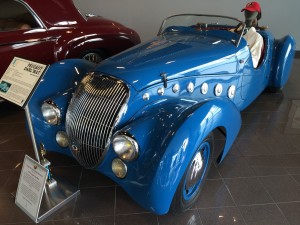
The Tampa Bay Auto Museum – A Tribute to Creativity and Imagination
During a visit to St. Petersburg, FL in early February we made an all-too-brief side trip to the Tampa Bay Auto Museum in the northern suburb of Pinellas Park. This amazing facility was opened in 2005 by Mr. Alain Cerf, the founder of privately-owned PolyPack, a manufacturer of highly-engineered automated packaging equipment for consumer products that was started in 1962 and whose headquarters is located directly next door.
The museum’s beginning resulted from the fact that PolyPack was doing so much business in this country that Mr. Cerf moved the company’s headquarters from outside Paris to its U.S. location more than 30 years ago. When he arrived, he brought a few cars that were important to him. Over the years, he added additional vehicles that became as best described in the museum’s website as “a unique collection of vintage cars and vehicles that demonstrate special creativity and imagination in their history and engineering.” The result is that Mr. Cerf’s apparent passion for innovative designs appears to play a large part in the criteria for selection of vehicles that are displayed, which now number over 60. And as a particularly interesting note, all of the vehicles in the collection are drivable.
X
Given its focus, the museum does a very good job in presenting each car’s story and technology provenance. This is particularly important, as it is probably safe to say that many of the vehicles in the collection are not ones that many American viewers are familiar. Additionally, a large number of the models have features or technologies that were incorporated into later production vehicles into the present day. European models such as the French Panhard Dynamic of 1936-1939, 1937 Peugeot Darl’Mat, German DKW Meisterklasse, and a host of pre- and post-war Tatras from Czechoslovakia represent just some of the types that might otherwise be seen solely at a concours event (many of the displays include trophies awarded at various concours).
Even more recognizable designs, such as the museum’s 1929 Ford Model A, are very different from those normally seen at car shows. The Model A, one of the almost 5 million produced between 1927 and 1931, was modified to run on charcoal (wood can also be used) as a creative way to overcome the challenge of gasoline shortages in Europe in the late 1930s and early 1940s. This early attempt at creating a hybrid vehicle uses a system (“gazogène technology”) manufactured in Spain in 1939. It works as follows: the driver ignites a fire in a tank at the rear of the car, sending the hydrocarbon gas through a larger tank. From here the gas is then pumped forward for combustion in the engine. Using this system the car was running on the island of Palma de Mallorca, near Barcelona, when it was discovered and eventually acquired for the collection. It still runs just fine on charcoal purchased from any local hardware store.

This photo illustrates the “gazogène technology” system mounted on the rear of the Tampa Bay Auto Museum’s 1929 Ford Model A, with the charcoal receptacle on the left and the hydrocarbon gas tank on the right
The museum offers a very special attraction in that it displays the only operating replica of the 1770 French Fardier de Cugnot. This is the world’s first self-propelled vehicle, combining an enormous wooden carriage with steam power that produces an operating speed of three miles per hour. It was built to move artillery pieces for the French army, so while seemingly slow its self-propelled mobility was undoubtedly a vast improvement over horse-drawn alternatives of the day. This vehicle is on loan from the Deutsche Bahn Museum in Nuremberg, Germany.
As a last item, the group in which the writer experienced the museum included several individuals who it can generously be said are not “car guys”. Despite this fact everyone appeared to enjoy their visit, particularly when our guide Gary LaSasso provided non-jargon technical descriptions of features and detailed human interest elements about the builders and designs. After witnessing this homage to innovation and creativity it was easy to be inspired by Mr. Cerf’s philosophy just as he is quoted in the museum’s website: “Work hard, pay your bills and taxes, and keep expenses down; but, don’t forget to dream and enjoy life.” ![]()
If you go:
Address: 3301 Gateway Centre Boulevard, Pinellas Park, Florida 33782
Hours: Monday, Wednesday through Saturday 10 a.m. to 4 p.m.
Sunday noon to 4 p.m.
Closed Tuesday and holidays
Admission: $8 per person
$6 for seniors
$5 for students or groups of 12 or more
Children under 6 are free
For more information: Website https://www.tbauto.org/index.htm
Phone 727-579-8226
Email info@tbauto.org
X
Photos by Andre Swygert
Check out the full gallery here:






